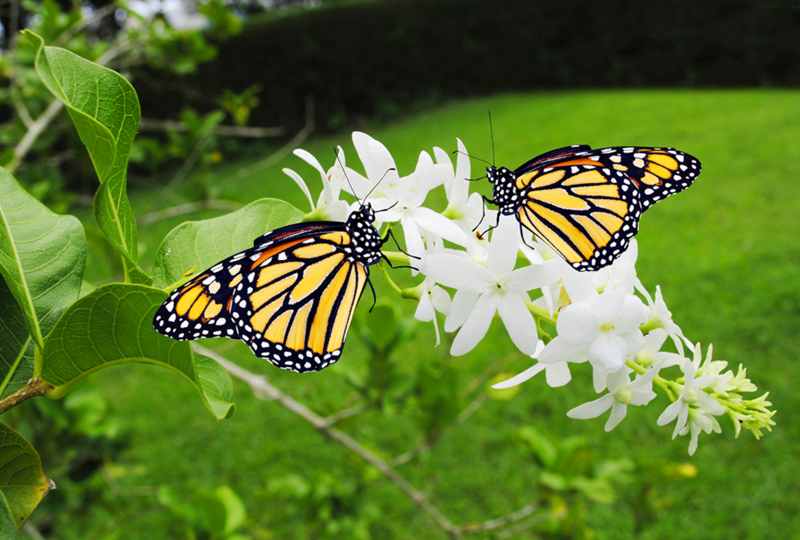
Key insights:
- Pollinators — including butterflies, bees, and birds — contribute to our food sources, crop production, and economy.
- To continue enjoying gardens and produce, we must work to maintain pollinator populations.
- Your yard can become a beautiful pollinator haven in a few simple steps.
The sun is out and it’s time to enjoy it. If you’re completing any DIY yard projects to keep up with landscaping trends this summer, consider planting a pollinator garden. Not only do pollinator gardens add a beautiful touch of color to any yard, but they also help support the environment.
What is a pollinator garden?
A pollinator garden is created for, you guessed it, pollinators! Pollinators are any species that collect pollen from one plant and deliver it to another. It’s important that this transfer of pollen happens because, without it, we wouldn’t be able to enjoy fruit from trees, flowers from gardens, or plants in nature.
Pollinators may be bees, butterflies, birds, or bats. These little insects and animals play vital roles in the health and growth of our plants and ecosystem. But, due to habitat loss, pesticides, and other factors, pollinators are in trouble.
Why are pollinator gardens necessary?
Pollinators are instrumental to food production worldwide. Plus, they contribute to healthy air, rich soil, and crop production. According to estimations, pollinators are responsible for 75% of the world’s flowering plants and about 35% of food crops.
How can I plant a pollinator garden?
Creating a pollinator garden can be simple. In fact, with these beginner landscaping tips, you’ll be well on your way to having a breathtaking garden that serves a greater purpose in your yard. Here’s what you’ll need:
To begin, choose the location of your garden. Any spot in your yard will suffice, but for the biggest impact, consider that butterflies enjoy basking in the sun and insects will benefit from some shelter from gusty winds. Once you decide where to place your garden, you’ll need to prepare the soil in that spot. To do so, remove the grass and rake the dirt below. Extra soil can be added to the area if needed. After the ground is prepped, you’re able to begin planting. Consider these tips when creating your pollinator garden:
- Purchase plants that have not been treated with pesticides or insecticides, which will kill off the pollinators that we are trying to help.
- Choose a variety of pollinator plants, including colorful flowers, Black-eyed Susans and Milkweed.
- Group similar flowers together — insects tend to have favorite flowers, and creating patches of flowers will make their job of pollinating easier.
- Plant perennials to ensure that your pollinator garden will last year after year.
Once your garden is complete, you can enjoy its beauty and the company of the pollinators. Be sure to follow the “Three W’s” of gardening during this time:
- Watch the growth and progress of your pollinator garden.
- Water your flowers to keep them healthy and strong.
- Weed the garden if necessary.
Keep in mind, a pollinator garden can be any size. So, if you have limited space or reside in a condo, you may still consider adding pollinator-friendly planters on your deck or balcony to create a small, yet effective space of refuge for pollinators.
Happy planting!
If you’re hoping to continue enjoying the sweet taste of honey and the sight of colorful summer gardens, it’s time to protect our pollinators. Give bees, butterflies, and other pollinating insects and animals a safe haven by planting a pollinator garden where you have space. And, if you’re hoping to spruce up your home to sell this summer, reach out to Edina Realty or one of our agents for additional help.









 ©2025 Prosperity Home Mortgage LLC®. (877) 275-1762. 3060 Williams Drive, Suite 600, Fairfax, VA 22031. All first mortgage products are provided by Prosperity Home Mortgage, LLC®. Not all mortgage products may be available in all areas. Not all borrowers will qualify. NMLS ID #75164 (For licensing information go to: NMLS Consumer Access at
©2025 Prosperity Home Mortgage LLC®. (877) 275-1762. 3060 Williams Drive, Suite 600, Fairfax, VA 22031. All first mortgage products are provided by Prosperity Home Mortgage, LLC®. Not all mortgage products may be available in all areas. Not all borrowers will qualify. NMLS ID #75164 (For licensing information go to: NMLS Consumer Access at